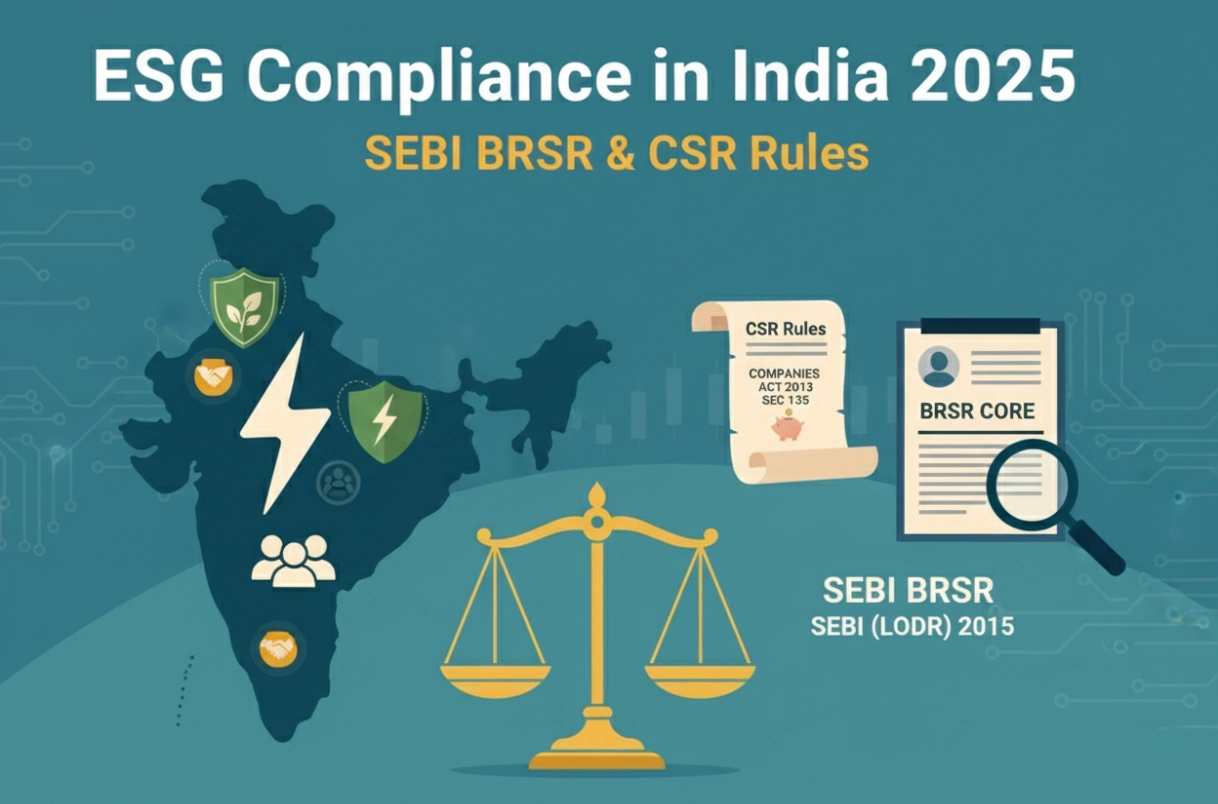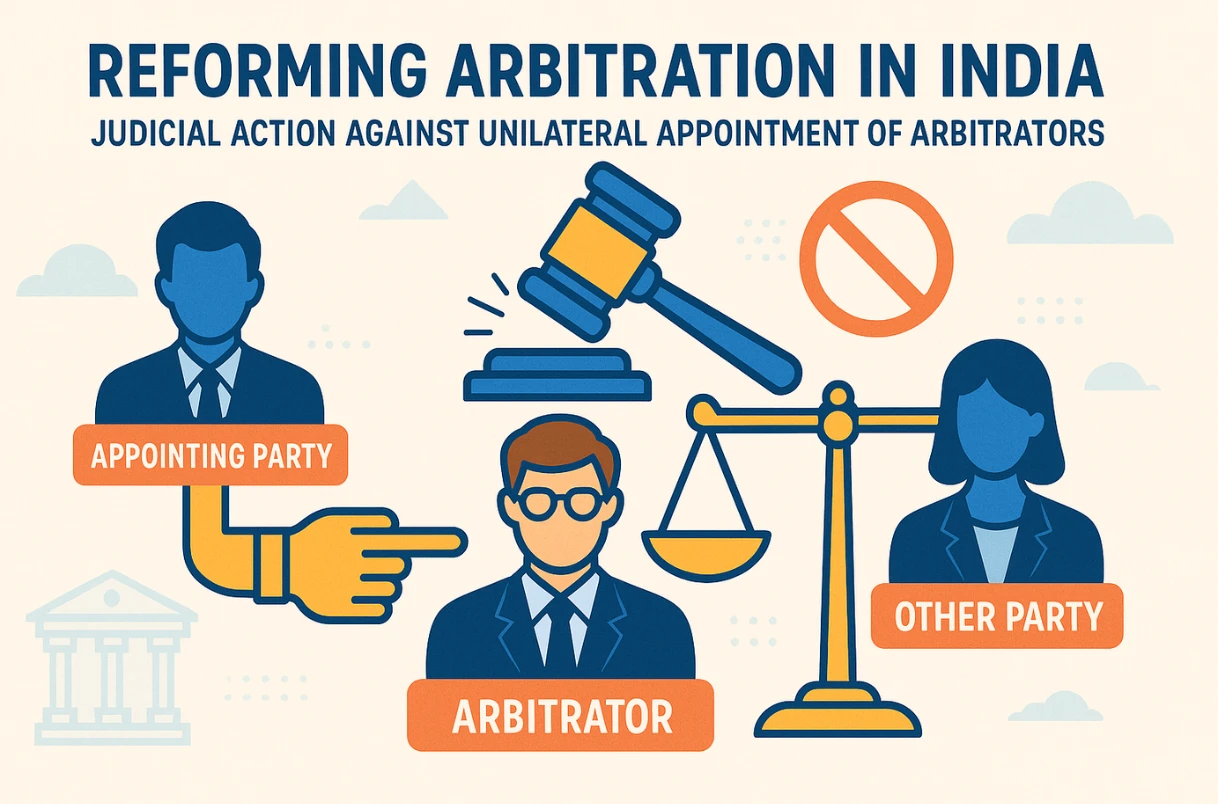ESG Compliance in India 2025 | SEBI BRSR & CSR Rules

By – Neha Das and Jane Kapai
Table of Contents
Introduction
Environmental, Social, and Governance (ESG) compliance, represents a structured framework that guides companies in adopting sustainable practices aimed at creating lasting ethical and environmental impact. Its modern articulation as a unified concept emerged in the United Nations’ 2004 report Who Cares Wins, which emphasized that ESG considerations are integral to long-term financial performance and risk management rather than mere peripheral concerns.1 Reinforced by later developments like the Sustainable Development Goals, 2015 and the Paris Agreement, 2016, today, countries worldwide have introduced ESG regulatory frameworks, compliance mechanisms, and reporting standards, each shaped by their unique economic, social, and political contexts.
The United States for instance, follows a complex mix of federal and state-level regulations, while the European Union pioneered mandatory disclosures covering ESG aspects for specific large EU public interest companies through its 2014 Non-Financial Reporting Directive (NFRD). Meanwhile, India has steadily advanced over the past two decades with policies, guidelines, and legislation designed to encourage sustainable and socially responsible business practices.
This article seeks to trace the evolution of ESG governance in India, examining statutory, regulatory, and judicial developments, while assessing structural challenges, and enforcement limitations. In doing so, it also highlights global practices such as those in the EU and the US to provide comparative insights and context for India’s ESG journey.
Evolution of ESG Governance in India
India does not have a single codified law governing ESG, rather its governance framework has evolved through a mix of statutory corporate social responsibility (CSR) obligations, mandatory disclosure requirements, and the gradual integration of ESG oversight into capital markets and banking regulation. What began as voluntary guidelines has progressively developed into binding mandates, shaped both by domestic developmental priorities and the expectations of global investors. Today, India’s ESG regime reflects a layered approach, combining sector-specific laws, rules, and regulations with voluntary governance codes that together form the backbone of its sustainability framework.
Against this backdrop, India’s ESG framework has taken shape through a mix of statutory mandates, regulatory measures, and voluntary codes. In order to delve into these frameworks of compliance, the following sections have been outlined.
Corporate Law Foundations
The Companies Act, 2013 was India’s first comprehensive legislative step in institutionalising ESG principles.
Mandatory CSR Spending under Section 135
Notably, Section 135 introduced mandatory CSR spending, requiring qualifying firms to allocate at least 2% of their average net profits from the preceding three years to activities specified in Schedule VII.2 Although path-breaking in making CSR compulsory, this provision often retained a philanthropic orientation, focusing on external community welfare rather than integrating ESG risks into governance and business models.
Expanded Directors’ Duties
A more substantive change came through directors’ fiduciary duties. Section 166(2) of the Companies Act, 2013 expanded the scope of directors’ duties by requiring them to act not only in the interests of shareholders but also in the interest of employees, the community, and the environment.3 Further, the Hon’ble Supreme Court’ s decision in Tata Consultancy Services v. Cyrus Investments reinforced this stakeholder orientation, emphasising that directors’ obligations extend beyond shareholder primacy to encompass broader responsibilities towards the community and the protection of environment.4
Board Disclosures and Risk Management
In addition to the above provisions, Section 134(3) of the Companies Act, 2013 requires the board of directors to disclose details of material changes, which may also include significant ESG related disclosures under section 134(3)(l)),5 as well as a statement indicating the development and implementation of risk management policy to be included in its annual report, under Section 134 (3) (n) of the 2013 Act.6
Gender Diversity on Boards
Pertinently, Section 149 of the 2013 Act, mandates the inclusion of a woman director on certain company boards a requirement,7 which is also reflected under Regulation 17(1)(a) of the Securities and Exchange Board of India (Listing Obligations and Disclosure Requirements) Regulations, 2015 (“LODR Regulations”), requiring the top 1,000 listed entities to appoint an independent woman director.8 Under Reg. 4(2)(f)(ii)(7) of the LODR Regulations, responsibilities of the board also include guiding risk policies and ensuring effective mechanisms for risk mitigation.9
Environmental and Social Baselines in Other Laws
Further, laws such as the Environment Protection Act, 1986, the Air (Prevention and Control of Pollution) Act, 1981, the Water (Prevention and Control of Pollution) Act, 1974, Prevention of Money Laundering Act, 2002 Air (Prevention and Control of Pollution) Act, 1981, and Factories Act, 1948, etc., although not originally conceptualised as ESG measures, have provided the environmental and social baselines on which modern ESG governance is layered, and had long imposed substantive compliance obligations on various industries.
SEBI Disclosures on ESG Reporting in India
The Securities and Exchange Board of India (SEBI) has played the most active role in embedding ESG into corporate governance. The SEBI issued the LODR, Regulations 2015, as a comprehensive framework to standardize compliance and disclosure requirements for listed companies. Reinforcing Section 134 (3) of the Companies Act, 2013, the LODR regulations also require listed companies under regulation 30(1) of the LODR to make disclosures of events or information that are, in the opinion of the board, material in nature.10 These ‘material events’ are provided under Schedule III, Part A, Clause B(6) and specifically includes disruptions to business operations caused by natural calamities like earthquakes, floods, or fires.
Business Responsibility Reports (2012)
In 2012, SEBI introduced Business Responsibility Reports (BRR) for the top 100 listed companies, drawing upon the Ministry of Corporate Affairs’ National Voluntary Guidelines on Social, Environmental and Economic Responsibilities of Business.11 Although largely narrative-based, BRRs signalled the start of a disclosure-driven approach.
Business Responsibility and Sustainability Report (2021)
In 2021, SEBI replaced BRRs with the Business Responsibility and Sustainability Report (BRSR), mandating disclosures from the top 1,000 listed entities under Reg. 34(2)(f) of the SEBI (LODR) Regulations, 2015. 12 Unlike its predecessor, the BRSR required both quantitative and qualitative disclosures on energy use, emissions, gender diversity, and governance practices, thereby improving comparability.
BRSR Core (2023) and Assurance Framework
The introduction of the BRSR Core framework in 2023, based on the nine principles of the National Guidelines for Responsible Business Conduct (NGRBC) and aligned with the Sustainable Development Goals, marked a further tightening of reporting standards. 13 Under the prescribed format,14 SEBI has identified a subset of Key Performance Indicators (KPI), such as Scope 1 and 2 greenhouse gas emissions, water consumption, gender diversity, wage parity, occupational safety, subject to independent assurance or third-party assessment undertaken as per the standards developed by the Industry Standards Forum (ISF) in consultation with SEBI.15
Value Chain Reporting (2025)
SEBI has also modified its Master Circular dated 11.11.2024 vide circular dated 28.03.2025, on compliance with the provisions of the SEBI(LODR) Regulations 2015 by listed entities, and notified voluntary ESG reporting for value-chain by top 250 listed company from FY 2-25-26, for which the assessment or assurance shall be applicable on voluntary basis from FY 2026-27.16 For the purposes of such reporting, value chain shall comprise of the top upstream and downstream, partners of a listed entity, individually comprising 2% or more of the listed entity’s purchases and sales (by value) respectively, and collectively making up at least 75% of its purchases/sales (by value) respectively.17
Penalties for Non-Compliance
In furtherance to the above disclosures under the SEBI (LODR) Regulations 2015, vide circular dated 22.02.2020, SEBI has established the structure for imposing penalties and initiating action against listed entities that fail to comply with the SEBI Listing Regulations, under which a penalty of ₹2,000 per day is levied for failure to submit the annual report under Regulation 34, including the BRSR disclosure.18
ESG and Sustainable Finance
The integration of ESG principles into capital markets and banking regulation reflects the systemic relevance of sustainability risks.
SEBI’s ESG Debt Securities Framework
The SEBI (Issue and Listing of Non-Convertible Securities) Regulations, 2021 (“NCS Regulations”) initially enabled issuance of green bonds, which were amended in 2024 to create a broader category of ESG debt securities in India, including, social, sustainable, and sustainability-linked bonds, and green debt securities.19 SEBI’s 2025 circular Framework for Environment, Social and Governance (ESG) Debt Securities (other than green debt securities)’ mandated detailed disclosure of use of proceeds, impact assessments, and third-party verification, while introducing safeguards against “purpose-washing”, under clause VII of the circular, which are misleading, false or incomplete claims made by the issuing entity on the purpose for which the sustainability or social bonds are issued.20
RBI Climate Risk Disclosure Framework
The Reserve Bank of India (RBI) has likewise embedded ESG into financial supervision. Its 2024 draft Disclosure Framework on Climate-Related Financial Risks, (RBI climate risk disclosure framework) requires banks and NBFCs to disclose four thematic areas to manage climate-related financial risks namely, governance, strategy, risk management and metrics and targets, under clause 7 of the framework titled ‘Thematic Pillars of Disclosure’.21 The draft guidelines are also aligned with globally available disclosure standards established by the Task Force on Climate- related Financial Disclosures (TCFD).22
RBI Green Deposits Framework
The RBI had also introduced a Green Deposits Framework in 2023, ensuring funds raised under such deposits are allocated exclusively to eligible green projects, with verification by independent third parties.23
IFSCA ESG Disclosures
Likewise, the IFSCA Circular , on Disclosures by Fund Management Entities for Environmental, Social or Governance (ESG) Schemes, dated 18.01.2023, required Fund Management Entities (FME) to integrate ESG into investment strategies and provide annual ESG disclosures, outlining the risks associated with pursuing ESG objectives and their risk management practices.24 Further, the IFSCA (Fund Management) Regulations, 2025, under Regulation 72, mandate FMEs with assets over USD 3 billion to disclose how they identify, assess, and manage sustainability risks, with governance policies and annual ESG performance reporting.25
ESG Rating Providers (ERPs)
With effect from 04.07.2023, SEBI has also introduced a regulatory framework for ESG Rating Providers (“ERPs”) vide an amendment to the SEBI (Credit Rating Agencies) Regulations 1999 (“CRA Regulations”), where it has defined “ESG ratings” under section 28B as ratings that provide opinion about the company’s ESG profile as well as its risks and impact related to governance, social issues, environmental and the climate change.26
Pursuant to the above, in order to strengthen the reliability and transparency of ESG ratings in India’s capital markets, SEBI issued the Master Circular for ERPs on 11.07.2025, (ERP Master Circular). The circular requires an ERP to offer six specified rating products under Chapter II clause 5, including among other rating products, ESG rating, core ESG rating based on third party assured/audited data, transition/ Parivartan score, to assess progress toward net-zero and broader ESG goals.27 The Master Circular also introduces mandatory annual internal audits for ERPs under clause 22 ensuring compliance with regulations, effective governance, conflict management, and robust operational controls.28
Unlike CSR, which is largely philanthropic in nature, it is apparent that ESG has shifted from focusing on the external impact of corporate activities to highlighting the financial risks and returns for investors when ESG issues are ignored in portfolio decisions and corporate engagement. This approach, often termed the Financial Model of ESG,29 emphasizes the role of capital and investors in advancing sustainable practices, rather than relying solely on corporate boards to act out of obligation toward broader stakeholder interests.
Stewardship Codes
Parallel to company-level obligations and financial regulations, India has also embedded ESG within the investment stewardship responsibilities of institutional investors. The Stewardship Code provides principles for institutional investors such as mutual funds and alternative investment funds, requiring them to monitor and engage with investee companies, integrate ESG considerations into their investment decisions, and manage conflicts of interest. By shifting investors from passive capital providers to active stewards, the Code strengthens corporate governance, enhances investor protection, and promotes long-term sustainable value creation.
The concept of stewardship codes, introduced by Indian regulators, underscores the role that institutional investors play as stewards of the companies in which they invest, thereby indirectly influencing corporate ESG practices. The Insurance Regulatory and Development Authority of India (IRDAI) for insurance funds, the Pension Fund Regulatory and Development Authority (PFRDA) for pension funds, and the Securities and Exchange Board of India (SEBI) for mutual funds and alternative investment funds have each issued stewardship codes. These codes require institutional investors to adopt stewardship policies that explicitly reference ESG considerations.
Structural Challenges- two lines
While India’s ESG governance reflects innovation and regulatory expansion, it also faces substantial structural challenges that undermine its credibility and impact.
- Greenwashing and Assurance Deficits
India faces risks of greenwashing as assurance standards under SEBI’s BRSR Core are not aligned with global benchmarks like ISSB or ESRS. Although SEBI has introduced third-party assessment as per the standards developed by the Industry Standards Forum (ISF), there is still lack of a similar uniform method of accreditation for assurance providers, as a result of which such disclosures may vary widely in terms of credibility. Further, in the absence of any defined standard of greenwashing and specific penalties to misleading statements on sustainability performance, the impact of greenwashing is significantly undermined, and verification of the same may turn into a mere compliance exercise, eroding investor trust.
- Cost of Implementation
Adopting eco-friendly practices raises operational costs, from solar installations to effluent treatment plants. For smaller firms, compliance and reporting costs often outweigh potential financial returns.
- Lack of Sector-Specific Taxonomies
India lacks detailed sector-specific taxonomies for green or sustainable activities, unlike the EU. This ambiguity leaves room for issuers to mislabel projects, raising risks of purpose-washing in ESG debt markets.
- Enforcement Limitations
Enforcement of ESG disclosures in India is weak compared to financial reporting. Limited regulatory capacity and absence of penalties reduce accountability for genuine sustainability outcomes.
ESG practice in EU
ESG compliance in the EU is regarded as among the most robust globally, driven by the Action Plan on Sustainable Finance.
Non-Financial Reporting and CSRD
The EU pioneered ESG regulation through the 2014 Non-Financial Reporting Directive (NFRD), requiring large public-interest companies to disclose environmental and social information, later strengthened by the 2021 Corporate Sustainability Reporting Directive (CSRD) requiring around 50,000 large and listed companies to make disclosures on ESG components.
EU Taxonomy and SFDR
Central to the EU framework is the EU Taxonomy (Green Taxonomy),30 a unified classification system clarifying which economic activities are environmentally sustainable and providing a framework for companies to calculate their sustainability-linked turnover. The Sustainable Finance Disclosure Regulation (SFDR) further complements these requirements that mandate entity- and product-level ESG disclosures from financial market participants.
Due Diligence and Climate Transition Plans
The EU has also introduced forward-looking measures such as the Corporate Sustainability Due Diligence Directive (CSDDD 2024), which imposes mandatory due diligence standards on companies and their value chains, both within and outside the EU.31 The directives oblige companies to identify, prevent, and mitigate adverse human rights and environmental impacts, while also adopting climate transition plans aligned with the Paris Agreement and its five-year decarbonisation milestones up to 2050.32
ESG Practice in the USA
The U.S. has a fragmented, yet evolving ESG regulatory landscape shaped by both federal and state regimes. The Securities and Exchange Commission (SEC) and the Federal Trade Commission (FTC), as key regulatory bodies play a significant role in shaping the country’s ESG framework on disclosure requirements.
SEC Climate-Related Disclosure Rules
While the SEC has recently adopted the Enhancement and Standardisation of Climate-Related Disclosures for Investors, 2024,33 requiring public companies to report significant climate risks, impacts on strategy, and mitigation measures, ensuring consistency and comparability for investors.
FTC Green Guides and Social Regulations
The FTC’s longstanding Green Guides regulate environmental marketing claims.34 Apart from such frameworks, The U.S. has strong federal frameworks focusing on social factors, as under the Civil Rights Act of 1964, Equal Pay Act of 1963, Age Discrimination in Employment Act, 1967, etc.
State-Level Nuanced Approaches
Comparably, the U.S. along with a uniform standard for ESG disclosures mandated by the SEC, and its various state legislations, enable a more nuanced approach in order to tailor to their individual and respective state economic, social and environmental challenges.
FAQs
-
What is ESG compliance in India?
ESG compliance in India means companies integrate environmental, social, and governance standards into their operations, reporting, and risk management. It is shaped by laws, disclosure mandates, and regulatory frameworks that link sustainability with corporate governance and long-term value creation.
-
How has India’s ESG regulatory framework evolved?
TIndia’s ESG regime has progressed from voluntary guidelines to binding obligations. Key milestones include mandatory CSR under the Companies Act, 2013, expanded fiduciary duties for directors, SEBI’s Business Responsibility and Sustainability Report (BRSR) disclosures, RBI’s climate and green finance measures, and stewardship codes issued by sectoral regulators.
-
What are SEBI’s ESG reporting requirements under BRSR?
SEBI requires the top 1,000 listed entities to file BRSR, covering both qualitative and quantitative ESG disclosures. The BRSR Core (2023) identifies key performance indicators—such as GHG emissions, water consumption, gender diversity, wage parity, and safety—that must be independently assured. Non-compliance attracts penalties under SEBI’s LODR framework.
-
What is the difference between CSR and ESG in India?
Corporate Social Responsibility (CSR) under the Companies Act focuses on community welfare through mandatory spending. ESG goes further, embedding environmental and social considerations into governance, risk, and finance. It emphasizes investor-driven sustainability and financial impacts rather than purely philanthropic contributions.
-
How does SEBI regulate ESG rating providers (ERPs)?
SEBI regulates ESG Rating Providers under the Credit Rating Agencies framework. ERPs must provide six specified rating products, disclose methodologies, manage conflicts of interest, and undergo annual internal audits to ensure reliability, transparency, and alignment with India’s ESG market.
-
What role does the RBI play in ESG compliance?
The RBI integrates ESG into financial supervision. Its Green Deposits Framework (2023) directs funds toward certified green projects, while the draft Climate Risk Disclosure Framework (2024) requires banks and NBFCs to disclose governance, strategy, risk management, and metrics aligned with the TCFD standards.
-
What are the major challenges in ESG implementation in India?
India faces multiple hurdles: greenwashing risks due to weak assurance standards, high compliance costs for smaller firms, lack of sector-specific taxonomies for sustainable activities, and weaker enforcement compared to financial disclosures.
-
How does ESG compliance in India compare with the EU and US?
The EU leads with mandatory ESG reporting, a unified taxonomy, and strict due diligence laws. The US framework is fragmented but evolving, with SEC climate disclosure rules and FTC’s Green Guides. India is advancing quickly but still trails in enforcement strength and sectoral classification systems.
-
What are greenwashing risks in India’s ESG framework?
Without uniform assurance standards or penalties, companies can exaggerate or mislabel their ESG achievements. This reduces credibility of disclosures, erodes investor trust, and risks turning compliance into a mere formality instead of a meaningful governance tool.
-
Why is ESG compliance important for Indian companies?
ESG compliance strengthens investor confidence, ensures adherence to regulations, mitigates long-term environmental and social risks, and aligns businesses with global sustainability benchmarks—making them more competitive in international capital markets.
References –
- https://neetiniyaman.com/wp-content/uploads/2025/09/1_WP-WhoCaresWins-2004.pdf
- Companies Act, 2013, §135
- Companies Act, 2013, §166(2).
- Tata Consultancy Services Ltd. v. Cyrus Investments Pvt. Ltd., (2021) 9 SCC 449, para 224
- Companies Act, 2013, §134(3)(l)
- Companies Act, 2013, §134(3)(n)
- Companies Act, 2013, §149
- https://neetiniyaman.com/wp-content/uploads/2025/09/89101215_SEBI-LODR-2015.pdf
- https://neetiniyaman.com/wp-content/uploads/2025/09/89101215_SEBI-LODR-2015.pdf
- https://neetiniyaman.com/wp-content/uploads/2025/09/89101215_SEBI-LODR-2015.pdf
- https://neetiniyaman.com/wp-content/uploads/2025/09/11_SEBI-BRS-2012.pdf
- https://neetiniyaman.com/wp-content/uploads/2025/09/89101215_SEBI-LODR-2015.pdf
- https://neetiniyaman.com/wp-content/uploads/2025/09/13_BRSR-Core-2023.pdf
- https://neetiniyaman.com/wp-content/uploads/2025/09/14_-SEBI-11-Nov-2024-MASTER-CIRCULAR-FOR-COMPLIANCE-WITH-THE-PROVISIONS-OF-THE-SEBI-LODR-REGULATIONS-2015-BY-LISTED-ENTITIES.pdf
- https://neetiniyaman.com/wp-content/uploads/2025/09/89101215_SEBI-LODR-2015.pdf
- https://neetiniyaman.com/wp-content/uploads/2025/09/16-17.-Circular_Modifying-Master-Circular-11.11.2024.pdf
- https://neetiniyaman.com/wp-content/uploads/2025/09/16-17.-Circular_Modifying-Master-Circular-11.11.2024.pdf
- https://neetiniyaman.com/wp-content/uploads/2025/09/18.-Circular_Non-compliance-with-certain-provisions-of-the-SEBI-Listing-Obligations.pdf
- https://neetiniyaman.com/wp-content/uploads/2025/09/19_SEBI-NCS-Regulations-2024-Amendment.pdf
- https://neetiniyaman.com/wp-content/uploads/2025/09/20_SEBI-2025-Circular-ESG-Debt-Securities.pdf
- https://neetiniyaman.com/wp-content/uploads/2025/09/21_RBI-Draft-Framework-Climate-Related-Financial-Risks-2024.pdf
- Task Force on Climate-related Financial Disclosures.
- https://neetiniyaman.com/wp-content/uploads/2025/09/23_RBI-Framework-for-Green-Deposits-2023.pdf
- https://neetiniyaman.com/wp-content/uploads/2025/09/24_IFSCA-2023-Circular.pdf
- https://neetiniyaman.com/wp-content/uploads/2025/09/25_IFSCA-FM-Regulation-2025.pdf
- https://neetiniyaman.com/wp-content/uploads/2025/09/26_SEBI-CRA-Reg-1999.pdf
- https://neetiniyaman.com/wp-content/uploads/2025/09/27-28_SEBI-Master-Circular-2025.pdf
- https://neetiniyaman.com/wp-content/uploads/2025/09/27-28_SEBI-Master-Circular-2025.pdf
- MacNeil, Iain & Esser, Irene-Marie, From a Financial to an Entity Model of ESG, EBOLR, 2022.
- European Commission, EU Taxonomy for Sustainable Activities.
- Directive (EU) 2024/1760 on corporate sustainability due diligence and amending Directive (EU) 2019/1937 and Regulation (EU) 2023/2859.
- Directive (EU) 2024/1760 on corporate sustainability due diligence and amending Directive (EU) 2019/1937 and Regulation (EU) 2023/2859, Article 22.
- https://neetiniyaman.com/wp-content/uploads/2025/09/33_SEC-Climate-related-disclosures-2024.pdf
- https://neetiniyaman.com/wp-content/uploads/2025/09/34_FTC-Green-Guides-2012.pdf


